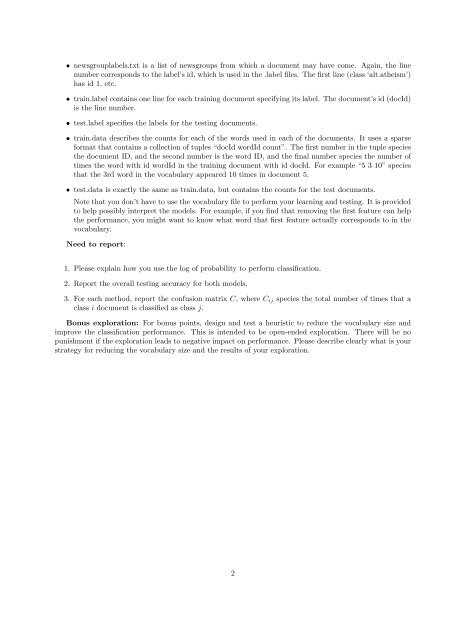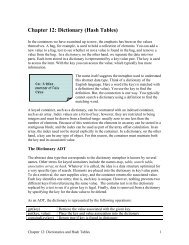Implementation assignment II - Classes
Implementation assignment II - Classes
Implementation assignment II - Classes
You also want an ePaper? Increase the reach of your titles
YUMPU automatically turns print PDFs into web optimized ePapers that Google loves.
• newsgrouplabels.txt is a list of newsgroups from which a document may have come. Again, the line<br />
number corresponds to the label’s id, which is used in the .label files. The first line (class ‘alt.atheism’)<br />
has id 1, etc.<br />
• train.label contains one line for each training document specifying its label. The document’s id (docId)<br />
is the line number.<br />
• test.label specifies the labels for the testing documents.<br />
• train.data describes the counts for each of the words used in each of the documents. It uses a sparse<br />
format that contains a collection of tuples “docId wordId count”. The first number in the tuple species<br />
the document ID, and the second number is the word ID, and the final number species the number of<br />
times the word with id wordId in the training document with id docId. For example “5 3 10” species<br />
that the 3rd word in the vocabulary appeared 10 times in document 5.<br />
• test.data is exactly the same as train.data, but contains the counts for the test documents.<br />
Note that you don’t have to use the vocabulary file to perform your learning and testing. It is provided<br />
to help possibly interpret the models. For example, if you find that removing the first feature can help<br />
the performance, you might want to know what word that first feature actually corresponds to in the<br />
vocabulary.<br />
Need to report:<br />
1. Please explain how you use the log of probability to perform classification.<br />
2. Report the overall testing accuracy for both models.<br />
3. For each method, report the confusion matrix C, where C ij species the total number of times that a<br />
class i document is classified as class j.<br />
Bonus exploration: For bonus points, design and test a heuristic to reduce the vocabulary size and<br />
improve the classification performance. This is intended to be open-ended exploration. There will be no<br />
punishment if the exploration leads to negative impact on performance. Please describe clearly what is your<br />
strategy for reducing the vocabulary size and the results of your exploration.<br />
2

















